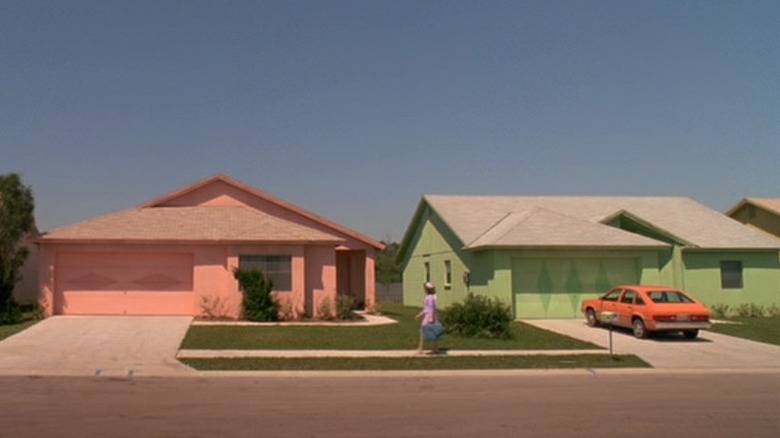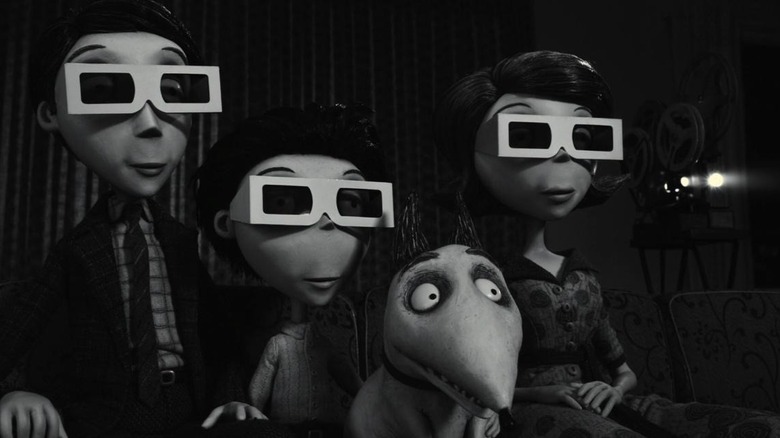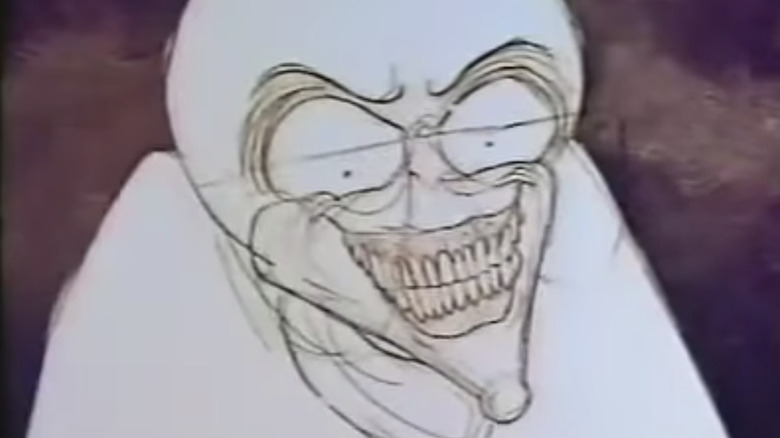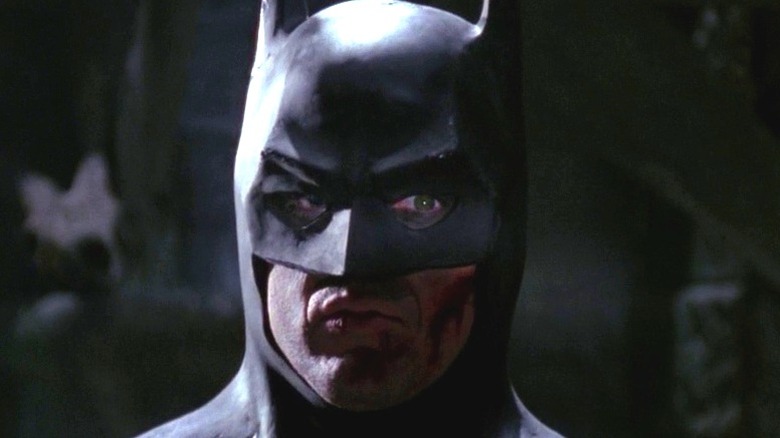Things Every Tim Burton Fan Should Know
Tim Burton is one of the most famous and idiosyncratic directors of his generation. His filmography includes massive commercial hits like "Batman" and "Alice in Wonderland" and enduring favorites like "Beetlejuice" and "Edward Scissorhands." Burton has translated his love of vintage Hollywood monster movies into a signature aesthetic of his own that combines mid-century suburban kitsch with the stuff of a child's nightmares.
For proof of how enduring Tim Burton's influence has been on pop culture, just walk into any Hot Topic store — his fingerprints are all over the place. Burton has always gravitated towards stories about outsiders, misfits, and people living double lives. While his subject matter and color palette are often grim, he's always looking for cuteness and innocence in the macabre.
His persona may be that of a mysterious, wild-haired weirdo, but Tim Burton's life and career is actually very well-documented through works like his autobiographical essay collection "Burton on Burton," numerous behind-the-scenes documentaries, and press attention to his relationships with former partner Helena Bonham Carter and friend and collaborator Johnny Depp. Here are a few essential bits of Burton mythology with which every fan should be acquainted.
Tim Burton grew up in an idyllic California suburb
Tim Burton was born and raised in Burbank, California, a suburban neighborhood of Los Angeles County. Burbank is the longtime corporate and creative headquarters of both Warner Bros. and The Walt Disney Company, intrinsically linked to the entertainment industry. (Burton would go on to direct massive hit movies for both studios.) His upbringing makes a lot of sense, as Burton became famous for off-kilter portrayals of American suburbia. "If you want to know what it was like growing up in Burbank," said Tim Burton in a 1999 interview, "watch 'Edward Scissorhands.'" Burton attests to feeling misunderstood in a cookie-cutter world of prefabricated houses and bland fashions, though he did try to fit in at some point.
"For a while I looked like I could have been on a casting call for 'The Brady Bunch,'" says Burton in "Burton on Burton." "I had bell-bottom pants and a brown leisure suit." Conformity to the standard Burbank attitudes and interests never fit Burton particularly well. "I think I was pretty much against society from the very beginning."
Burbank being an entertainment town meant that Burton grew up surrounded by movie theaters, which at the time played not only new releases but classic horror movie triple features. It was also the age of the TV horror movie matinee, which exposed a young Tim Burton to the moody, sometimes gruesome monster movies that would inspire his work as an adult. As he put it, "Every kid responds to ... some fairy-tale image, and I felt most monsters were basically misperceived. ... For a while I wanted to be the actor who played Godzilla."
He started making films at a young age
Burton and his childhood friends began shooting films — mostly monster movies — on a Super 8 camera when he was still a teenager. The earliest Tim Burton film that we know about is 1971's "The Island of Doctor Agor." Even at 13, he experimented with stop-motion animation, inspired by Ray Harryhausen movies like "Jason and the Argonauts." Uninterested in school, Burton found ways to get away with spending time making films instead of doing his homework. When assigned to write an eighth-grade book report on Harry Houdini, he shot a short film about Houdini instead, casting himself in the lead. He got an A, without having actually read the book.
For Burton, movies were something to do for fun, a way to express himself rather than a career path. Burton was also an artist and saw this as a more practical way to make a living. After high school, he won a scholarship to study animation at the California Institute of the Arts (often shortened to CalArts), a school co-founded in Burton's native Burbank by Walt Disney. CalArts remains one of the key feeders into the American animation industry today. Burton would continue to shoot Super 8 movies during his time at CalArts, but he expected to be a professional animator and remain only a hobbyist filmmaker.
Burton's class at CalArts is legendary
In 1976, Burton started school at CalArts, where their Disney-sponsored Character Animation program was only just spinning up. The 1970s were a bust period for American feature animation, a time when even Disney was struggling to innovate the medium and excite audiences. Disney hired aggressively from the new Character Animation program in the hopes that this new blood would revitalize their studio, and it worked — Burton's classmates would include some of the most important animation directors of the 1990s, including John Musker ("The Little Mermaid," "Aladdin"), John Lasseter ("Toy Story"), Brad Bird ("The Iron Giant"), and Henry Selick ("The Nightmare Before Christmas").
"I think the rest of CalArts thought the Character Animation people were the geeks and weirdos," Burton told Vanity Fair in 2014. "It was the first time you met people that you could kind of relate to, in a strange way."
Even among a self-selecting sample of outcast artists, Burton was still a relative oddball. He'd engage in long, competitive staring contests with future Disney art director Michael Giaimo or just sit alone in a dark closet for hours at a time. Burton's work also stood out, as his horror-inspired short "Stalk of the Celery Monster" won him a job at Disney after his third year of study. In "Burton on Burton," the filmmaker attributes his hiring more to Disney's desperation for new talent than to the quality of his work.
Tim Burton's short stint at Disney shaped his career
Tim Burton was recruited out of CalArts by Walt Disney Studios in 1979 and was quickly put to work on the animation team for the feature "The Fox and the Hound." Animation is grueling work in general, but the situation was more frustrating than usual for Burton as he found nothing in the material to relate to. Drawing cutesy, talking animals on a trek through the forest was not a particularly good fit for him. "For a year, I was probably more depressed than I have ever been in my life," he writes in "Burton on Burton."
After "The Fox and the Hound," Burton found a more appropriate position as a conceptual artist for "The Black Cauldron," which allowed him to design creatures and monsters closer to his own idiom. None of his work was used in the film, but it did catch the eye of a few Disney executives who gave him the budget to co-direct a stop-motion short, "Vincent." "Vincent" is as autobiographical as Burton films get, the story of an average suburban kid who fantasizes that he's a tortured mad scientist in the vein of horror icon Vincent Price.
On the strength of this work, Disney hired Burton to direct his first professional live-action short, an effects-heavy adaptation of "Hansel and Gretel" for the nascent Disney Channel. Next, they set him loose to create his original live-action short "Frankenweenie," which he would adapt into an animated feature nearly 30 years later.
Burton has partnered with composer Danny Elfman from the beginning
With a few short films under his belt, Tim Burton was invited to direct "Pee-Wee's Big Adventure," a feature film inspired by Paul Reuben's stage-based "Pee-Wee Herman Show." Burton's dark but childlike lens seemed like the right fit for Reuben's bizarre character, and the movie was a hit that allowed Burton to move on to more ambitious projects. It also marked the beginning of one of his most fruitful creative partnerships.
Burton had been a fan of the surrealist new wave rock band Oingo Boingo for years, and he hired their frontman and songwriter, Danny Elfman, to compose the music for "Pee-Wee's Big Adventure." Elfman had only one composing gig under his belt (his brother Richard's 1980 feature "Forbidden Zone") and was sure that his "Pee-Wee" score would never even make it to the screen. Instead, it launched one of the most successful musical careers in Hollywood.
Elfman has scored nearly all of Burton's feature films to date. The duo took a break from each other after the strain of making "The Nightmare Before Christmas," which led to Howard Shore composing the score to 1994's "Ed Wood." They reconciled shortly thereafter, with Elfman only sitting out two films since — "Sweeney Todd" in 2007 (as it was an adaptation of a musical that had its own score already) and "Miss Peregrine's Home for Peculiar Children" in 2016 (for reasons unknown).
Batman made Tim Burton a brand in his own right
The critical and box office success of Burton's second feature, "Beetlejuice," gave Warner Bros. the confidence to hire him to direct a new feature film adaptation of "Batman." In the late 1980s, a big-budget superhero movie was a very risky undertaking, and neither the studio nor the rabid comic book fans were terribly excited about Burton and producer Jon Peters' choice for the lead role, comedic actor Michael Keaton. Comics fans wrote letters in droves to protest Keaton's casting, but audiences were won over in record numbers when the 1989 film earned a worldwide gross of $411 million. (In 2021 dollars, that's over $900 million.)
The clout he'd earned from directing "Batman" gave Burton a blank check (though at different studios) to create his passion projects. Burton hired novelist Caroline Thompson to develop his fairy-tale concepts "Edward Scissorhands" and "The Nightmare Before Christmas" into full screenplays, and the resulting films became the ur-examples of the Burton aesthetic. "Scissorhands" was another hit, cementing not only Burton's place on the Hollywood A-list but launching the movie career of Johnny Depp, who had previously been known mostly for his role on the TV series "21 Jump Street." The Burton-produced "Nightmare Before Christmas" was only modestly successful at the box office, but it's since become a holiday classic and a merchandising giant.
He didn't direct The Nightmare Before Christmas
The poster reads "Tim Burton's The Nightmare Before Christmas" and not without reason. Burton initially composed the story of the Pumpkin King's voyage to Christmastown as a poem in the early 1980s while he was still working for Disney. He pitched "Nightmare" as a stop-motion TV special in the vein of "Rudolph the Red-Nosed Reindeer," producing storyboards and a model of protagonist Jack Skellington with animation collaborator Rick Heinrichs, but none of the networks would commit to it.
After his success with "Batman," Burton sought to revive the concept but discovered that, because he had developed it while under contract to Disney, Disney owned the story and characters. Disney was, at least, enthusiastic about the project and wanted to develop it into a feature film. However, this was too time-consuming a project for Burton to take on himself, so he instead asked fellow CalArts graduate and Disney colleague Henry Selick to direct the feature.
Selick took the lead on the grueling day-to-day animation process, staying in frequent contact with Burton and adhering closely to his creative vision. Other previous Burton collaborators were brought in, like composer Danny Elfman, writers Michael McDowell and Caroline Thompson, and actor Catherine O'Hara. Still, Selick shouldn't be counted out as the filmmaker. He's also the director responsible for the cult classics "James and the Giant Peach" and "Coraline."
His most acclaimed film was his biggest commercial flop
Burton's 1994 film "Ed Wood" is an off-kilter biopic about failed Hollywood filmmaker Edward D. Wood Jr., the director behind such schlocky classics as "Plan 9 from Outer Space." "Ed Wood" is a departure from much of Burton's filmography as it takes place in something much closer to the "real world" rather than a stylized fantasy, and it's an adaptation of a real person's life.
However, it's still very much a Tim Burton film, starring one of his favorite lead actors, Johnny Depp, as a character who's an outsider living something of a double life. "Ed Wood" won two Academy Awards (for Makeup and Best Supporting Actor for Martin Landau) and holds a 92% on the Tomatometer, the highest score of any film he's directed. It's common to find "Ed Wood" at the top of critics' rankings of Burton's filmography.
Despite its critical acclaim, "Ed Wood" was a bomb at the box office, making less than $6 million in US theaters on a budget of $18 million. Burton's career was already pretty much bulletproof at this point, so the poor returns didn't bother him too much. "I guess if I was left to my devices I wouldn't think about how much money [my movies] make," he wrote in "Burton on Burton," going on to add, "So when ['Ed Wood'] didn't make any money, I felt a little like, 'Well, it just goes to show that you never really know.'"
He almost made a Superman movie
In the late 1990s, Tim Burton was invited by Warner Bros. to direct a relaunch of the Superman movie franchise called "Superman Lives." Burton's take on the character was exactly what you might expect — he was attracted to the idea of exploring Superman as an alien, an outsider who had to hide parts of himself from the world.
Development of the project preceded Burton's involvement by months, and a number of key decisions had been made by the time he came on board. What was certain was that the film would loosely adapt the popular comic book storyline "The Death and Return of Superman," and it would star Nicolas Cage (a major comics fan) in the title role. A script had been commissioned from "Clerks" and "Chasing Amy" writer-director Kevin Smith, which Burton scrapped immediately upon signing on to direct.
The script and concept art phase for "Superman Lives" went on for a year, with a costume being designed by Burton regular Colleen Atwood and hundreds of concept drawings being commissioned from a variety of artists. But after a string of their would-be blockbusters underperformed in theaters, Warner Bros. became sheepish about the cost of the project and pulled the plug, rerouting its budget towards what seemed like a safer bet at the time — "Wild Wild West." (This did not pay off very well.)
He works with the same actors and crew members for long stretches of films
Tim Burton has a habit of utilizing a lot of the same cast and crew on his films. One of his most famous long-term creative partnerships is with composer Danny Elfman, who's composed the score to 16 of his films, plus "The Nightmare Before Christmas."
Costume designer Colleen Atwood has worked on 11 Tim Burton films, including "Alice in Wonderland," for which she won an Academy Award. (She has a total of four Oscars.) Production designer and animator Rick Heinrichs has the longest working relationship with Burton, going all the way back to his first short films for Disney in the early 1980s and continuing through to the present day, totaling 10 feature collaborations.
In front of the camera, Burton is well-known for casting his close friend Johnny Depp in leading roles, beginning with the career-making "Edward Scissorhands." Depp received top billing in five Burton films in a row between 2005 and 2012, and he's starred in a total of eight. And Helena Bonham Carter has played a supporting role in seven consecutive Burton films, a record that's unlikely to be broken.
Other members of the recurring Burton company include Deep Roy (most notable for portraying all of the Oompa Loompas in "Charlie and the Chocolate Factory"), Danny DeVito (who's played three different circus performers for Burton), Christopher Lee, and Michael Keaton.
Burton and Helena Bonham Carter were partners for 13 years
Among Tim Burton's most frequent collaborators is English actor Helena Bonham Carter, whom he met while directing her in his disastrous "Planet of the Apes" adaptation in 2000. Burton and Carter would live together in London for years, and they parented two children. Their relationship often garnered press attention, particularly when the couple moved into two adjoining houses. (Carter cited Burton's snoring as the cause for their separate homes, though we'll wager she was halfway joking.) Even since their separation in 2014, Burton and Carter have remained close friends, as well as co-parents. Carter featured in every one of Burton's films during their relationship.
Prior to meeting Carter, Burton had been in a decade-long relationship with actor Lisa Marie, who appeared in four of his films and was his personal manager for a time. (This break-up was far more contentious.) Due to Burton's pattern of casting his romantic partners in films, the rumor mill kicked into gear when Eva Green starred in three straight Burton features, but Green says that their admiration for each other is purely professional.
Tim Burton has never won an Oscar
Tim Burton casts a long shadow in Hollywood, and his films have grossed over $4 billion in total box office. At the time of this writing, he's the 10th highest-grossing director of all time. But unlike contemporary legends such as Steven Spielberg, Peter Jackson, and James Cameron, Tim Burton has neither won nor even been nominated for an Academy Award for Best Director. He has two Oscar nominations to his name, both for Best Animated Feature — for "Corpse Bride" and "Frankenweenie." Both films lost, to "Wallace & Gromit in The Curse of the Were-Rabbit" and "Brave," respectively. (The Best Animated Feature Oscar category did not yet exist in 1993, when "The Nightmare Before Christmas" was released.)
Every once in a while, a Burton film will attract Oscar attention, like "Ed Wood" and "Sweeney Todd," but never for Burton himself. This doesn't seem to bother him. While promoting "Frankenweenie" ahead of its Oscar night in 2013, Burton told Deadline that if he ever thought about a movie in terms of its Oscar potential, he "wouldn't be able to do a project!" That's just as well — as a self-described outsider, it would be out of character for Tim Burton to be fixated on a popularity contest, even one as prestigious as the Academy Awards.












